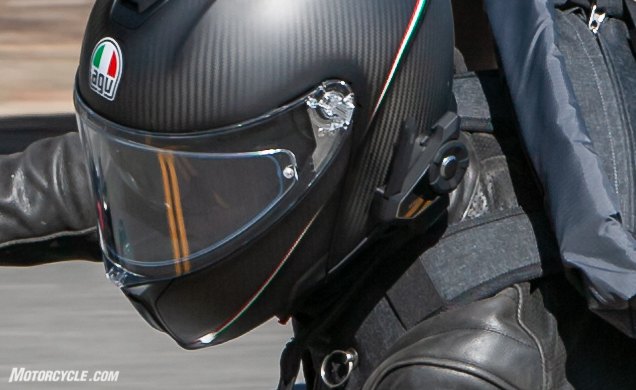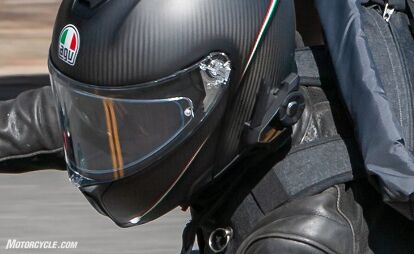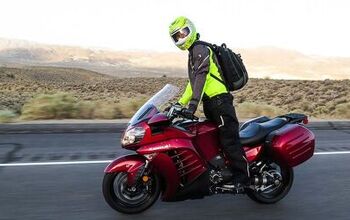MO Tested: Sena 30K Communicator

Embracing convenient, new technology but missing the polish of earlier Sena units
I love helmet communicators. Using them has changed the way I ride. In fact, when testing new helmets, one of the first things I do (once I become familiar with the noise levels in the helmet) is install a communicator. I ride so many places where I use turn-by-turn directions that I can’t imagine going back to the bad old days of taping directions on the gas tank. Until Sena released the 30K, the company’s 20S/20S EVO units were my go-to communicators. So, you can imagine my excitement when it came time to test the 30K which takes all the features of the 20S and adds the new, easy-to-use mesh communication technology to the mix.
Sena 20S Motorcycle Bluetooth Communication System Review
MO Tested: Sena 20S EVO Motorcycle Bluetooth Communication System Review
MO Tested: Shoei Neotec II Helmet + Sena SRL Communicator Review
Sena began with the 30K by, quite literally, not reinventing the wheel. First, the form factor of the 30K – with its large scroll wheel – will be instantly familiar to 20S users. The 30K also utilizes the same mounting hardware so that riders who upgrade to the 30K can simply slip the new module into place and riders with multiple helmets can switch the unit between helmets with the push of a button (if they purchase extra mounts).
But I’m burying the lede here. The big news about the 30K is the inclusion of mesh technology. This new connection method makes it easy to link up communicators with two or more riders. Previously, the riders had to pair their Bluetooth connections and then join a group conversation in a daisy chain. If a person in the middle of the chain dropped out, so did every other rider in the group that was behind that person in the chain.
Mesh communication is different, and Sena’s implementation has two modes, public and private, which, aside from the obvious differences implied in their names, essentially work the same way. As riders move into and out of the group communication, they are seamlessly added and removed from the mesh. When in Public Mode, any rider within mesh range with a Sena 30K will automatically connect and be able to join in the conversation. In Private Mode, you can connect up to 16 riders into the mesh. Also, riders with Bluetooth communicators can connect to the mesh by maintaining a Bluetooth intercom connection with a member of the mesh.
Sena claims up to a 1.0-mile range with Public Mode and a 1.2-mile range in Private Mode. Additionally, Sena claims that the private mesh can be extended up to 5.0 miles by jumping across multiple mesh participants. Since we only had two units, we were not able to test the length of a multi-party Private Mesh. We did, however, test the range between two units and found it to be well short of the claimed range. In both meshes, our usable range was a maximum of one-half mile. Oddly, the Bluetooth range with an older Sena SMH10 was about 10% further than the mesh mode. To make matters worse, this was in direct line-of-sight conditions that should provide optimal range. This was not on mountain roads where the topography could shorten the range. We can report that the Bluetooth bridge mode was easy to set up and did an effective job of linking the SMH10 to the 30K mesh network. The last criticism against the Sena mesh is that it kills the battery of the units much quicker than the old Bluetooth system. In my months of testing the 30K, I was never able to get a full day’s ride using mesh communication out of a charge, requiring that I carry a battery for a quick charge at lunch.
Unfortunately, the bad news about the 30K doesn’t end there. The electronic whine that I mentioned in my Sena 20S EVO review is present when wearing headphones with the 30K, too. Additionally, the 30K has some volume issues where, after taking a call or receiving directions from Siri, the music occasionally returns quite loudly. When I attempt to adjust the volume, it drops to almost zero, requiring that I turn it up to the level I previously had it set. This is really annoying and distracts the rider’s attention from the road – particularly when wearing headphones, as the volume is shockingly loud. I have not been able to predictably cause this issue to occur, but it does involve playing music and having another audio function temporarily interrupt the sound.
One audio feature that I absolutely couldn’t live without on the Sena 20S/20S EVO/30K is Ambience, which turns on an external microphone and allows me to hear what is going on around me. This makes gas station conversations much easier, and I wish all communicators had this feature. Just remember to turn it off before you start riding, or you’ll quickly learn how noisy it is outside of your helmet.
As with the Cardo System PackTalk Bold, Sena also utilizes voice commands. In fact, Sena’s list of commands is much longer than those utilized by Cardo. Sena uses a call and respond approach. You begin by saying, “Hello Sena,” and the 30K responds with, “Say a command.” Then you give the command. While this eliminates any confusion as to whether the unit is ready to receive a command, it does add an extra step to the process. I found the 30K’s voice command (which is also available in the 20 S EVO) to work quite well around town; however, at highway speed, the system worked about 60% of the time – at best. Since the buttons and dial are so easy to operate manually, I usually avoided the frustration and just adjusted settings manually.
I would be remiss if I didn’t include a section in this review concerning the importance of speaker placement within the helmet. After my positive experience with the Sena SRL in a Shoei Neotec II helmet (where the speaker pocket in the helmet exactly matches the location of my ears), I realized that speaker placements that vary be even as little as a half an inch can have a dramatic influence on sound volume and quality. So, I experimented on moving the 30K’s speakers out of the pockets built into the helmet to get them as close as possible to my ear canals. To achieve this location, I had to place the spacers that are included in the installation kit into the speaker pocket to provide a level mounting surface. I ended up with my speakers only halfway over the lower portion of the speaker pocket. The improvement in sound quality now allows me to use earplugs when I ride and still be able to clearly hear GPS directions, music, and phone calls. When touring, I’ll still keep using my noise isolating earphones, but that’s more of a personal preference than a requirement. So, don’t be afraid to experiment with speaker location to get the best sound.
As an avid user of helmet communicators, the Sena 20S form factor (of which the 30K is a variant) has been my preferred system for several years. So, it saddens me to say that the Sena 30K, while offering significant new technology in the form of mesh communication, does not feel like a more advanced unit. Mesh communication dramatically shortens battery life to the point that the 30K can’t last a full day’s ride, and in my experience, the range is no better than Bluetooth. Then there is the whine for headphone users and the intermittent volume fluctuations. Hopefully, the battery and audio issues that I encountered can be addressed in a firmware update, but until then, I can’t recommend the Sena 30K – unless your riding group has already adopted the 30K as its communication system.
To learn more about the Sena 30K – and buy directly from the manufacturer – visit the company website.

Like most of the best happenings in his life, Evans stumbled into his motojournalism career. While on his way to a planned life in academia, he applied for a job at a motorcycle magazine, thinking he’d get the opportunity to write some freelance articles. Instead, he was offered a full-time job in which he discovered he could actually get paid to ride other people’s motorcycles – and he’s never looked back. Over the 25 years he’s been in the motorcycle industry, Evans has written two books, 101 Sportbike Performance Projects and How to Modify Your Metric Cruiser, and has ridden just about every production motorcycle manufactured. Evans has a deep love of motorcycles and believes they are a force for good in the world.
More by Evans Brasfield








































Comments
Join the conversation
Bluetooth many-to-many (m:m), or mesh networking, is a bluetooth
standard available to any manufacturer who wishes to use it. It is a
shame that both Sena and Cardo have chosen to cripple their
implementations to only allow connections between their own branded
units.
https://www.bluetooth.com/b...
I'd urge people to check the Sena forums before buying the 30k... I've had a pair of them for nearly a year and they're not working well. One failed and had to be replaced (which took 6 weeks), and neither of them are what I'd call reliable performers. Mesh will sometimes start out working ok if there are no bluetooth users but generally within 30 minutes we start to get lag and audio breakup issues which force us back to bluetooth mode. Bluetooth mode works OK but I find myself having to reboot the headset periodically because audio gets static'y for no reason. More worrying is that we're not seeing firmware updates addressing the problems like we did with the 10's.